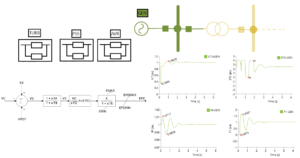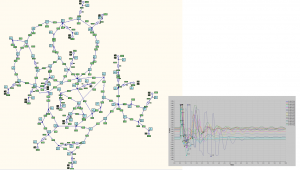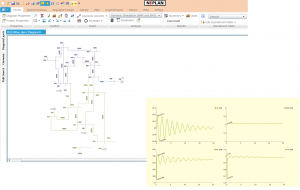The module RMS Stability Analysis is one of the most advanced tool for dynamic simulations on the market and allows to simulate symmetrical and unsymmetrical networks and events. It implements a unique mathematical framework for large-scale, nonlinear system with fast/slow continuous and discrete (hybrid) events. The initialization of the mathematical model is performed by high sophisticated algorithms in an automatic way and is fully integrated. The time-consuming model-specific initialization process could be omitted. The NEPLAN Simulation Language (NSL-SymDef) is used for user-defined models, but an extensive built-In library for e.g. Wind turbines (IEC 61400-27-1 standards), Photovoltaic (CIRED standard) and CIM ENTSO-E models is also available.
Main characteristics:
- Short-term, mid-term and long-term dynamic simulations
- Symmetrical and asymmetrical AC and DC networks (same as for steady state calculation)
- Simulation of symmetrical conditions and events in DQ0 reference frame for higher performance
- Simulation of unsymmetrical conditions and events in ABC reference frame (multi-phase system)
- High accuracy and performance (simulation in real-time) with fixed and variable step-size algorithm
- Simulation of any fault or event, see examples below
- Behavior of protection devices in pre-defined library are considered during simulation, see examples below
- User defined protection models described by equations or function blocks
- Transient Motor starting for synchronous and asynchronous machines with start-up devices
- Model definition through NEPLAN Simulation Language and compiling to Dynamic Link Library (DLL)
- Graphical editor for creating models (AVR, relay, etc.) through function blocks and automatic compilation to Dynamic Link Library (DLL)
- Open framework to monitor and control any variable in the network system
- Co-simulation with external systems
- Frequency Analysis with Fast Fourier Transform (FFT)
Typical applications
- Grid Interconnection Studies for Renewable Energy and verification of grid code compliance
- Machine dynamics and startup simulations
- Rotor angle stability with several different type of regulators
- HVDC-(light), FACTS, SVC design and regulation
- Load shedding and protection schemes
- Automatic generation control (AGC)
- PSS tuning with Eigenvalue and Sensitivity analysis
- Wide area network controllers
Typical protection models
- Min-max relays (e.g. over current, under voltage, power and frequency): modeled with the possibility to trigger of any desired event (e.g. switching in/off an element, increase/decrease load, loss of excitation). Various load shedding schemes can be easily simulated
- Overcurrent relays, circuit breakers and fuses
- Pole slip relays, including binary input signals from external sources
- Out-of-step protection including Power Swing Blocking (PSB) and Out of Step Tripping (OSP)
- Distance protection with any characteristic: pickup and tripping stages, impedance diagrams, binary input signals from external sources
Typical disturbances (events)
- Possibility of defining and saving various disturbance groups, with different single event per case
- Definition of different faults (symmetrical and unsymmetrical) on buses, bus elements, branches
- Different switching operations (feed-forward control in control circuits, cross coupling of protective devices, in/out of branches, etc.)
- Loss of generator excitation
- Start-up of motors with different start-up devices
- Transformer tap modification
- Load shedding scenarios (even in relation with frequency relay)
- Disturbances with function activation (step, ramp, sinusoidal function or combination)
- User-defined disturbances (every variable can be modified in the network/control)
- Definition of specific voltage profile on buses for Low Voltage Ride Through (LVRT) and Over Voltage Ride Through (OVRT)
Brochure: Introductory brochure for stability analysis could be found here.
Videos:
- Introductory video to Dynamic (Stability) analysis could be found here.
- Learning video for modelling controllers for Stability analysis with NSL-SymDef could be found here.


